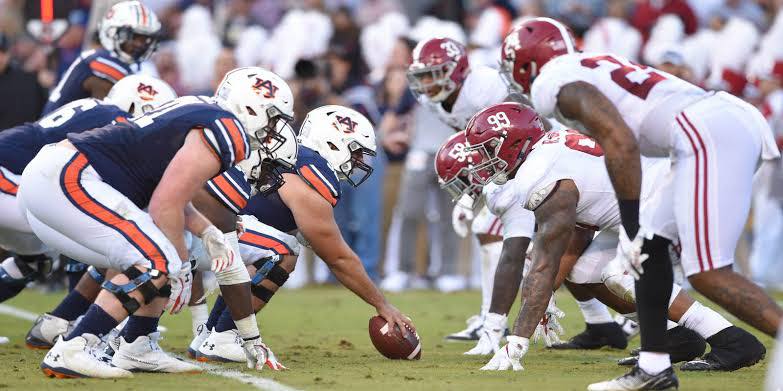Netflix released a gripping sports documentary focusing on the intense rivalry between the Auburn Tigers and the Alabama Crimson Tide, often referred to as the Iron Bowl
The documentary begins with a powerful aerial shot of the iconic Jordan-Hare Stadium in Auburn, Alabama, and Bryant-Denny Stadium in Tuscaloosa, Alabama, both considered cathedrals of college football. The camera zooms in on the packed crowds and the deafening sounds of fans clad in their respective colors—Auburn’s navy and burnt orange and Alabama’s crimson and white. The sense of anticipation is palpable, with the Iron Bowl looming large in the distance.
Narrator’s voiceover: “In the heart of the South, there’s a football rivalry unlike any other. It’s not just about wins and losses. It’s about pride, tradition, and history. This is the Iron Bowl.”
The Origins: A Southern Legacy
The documentary takes us back to the origins of the rivalry, tracing its roots to the late 1800s when Auburn and Alabama first met on the football field. In the early years, the rivalry was marked by harsh competition but also mutual respect. The documentary highlights the socio-political climate of the South in the late 19th century, where college football was emerging as a cultural phenomenon, especially in Alabama.
Expert commentary from historians explains how the rivalry grew alongside Alabama and Auburn’s contrasting identities. Auburn represented the agricultural and economic backbone of Alabama, while Alabama, with its dominant football program, became synonymous with Southern power. The documentary reveals that while these two teams started as state rivals, the game’s importance rapidly escalated.
“As the years went on, the Iron Bowl became more than just a game—it became the defining moment of the season for these two schools,” says Dr. William Carter, a sports historian.
The Rising Intensity: From Friendly Competitors to Bitter Rivals
As the 20th century unfolded, the rivalry shifted from respectful competition to bitter animosity, particularly during the 1980s and 1990s. The documentary delves into pivotal moments that shaped the fierce nature of the rivalry.
One significant event was the infamous “Punt Bama Punt” game in 1972, when Auburn’s defense stopped Alabama from a potential victory by blocking two punts in the final minutes, sealing a dramatic upset. Interviews with former players and coaches recount the sheer tension that enveloped the game and how it ignited the already-charged emotions between the teams. Auburn’s coach at the time, Ralph “Shug” Jordan, is shown speaking on his belief that the Iron Bowl was the most important game of the year, regardless of the team’s overall season record.
The documentary also touches on Alabama’s dominance under legendary coach Bear Bryant during the 1970s, when the Crimson Tide often trampled their rivals. As one former Auburn player puts it: “Bear Bryant was a figurehead, but that didn’t mean we were ready to just roll over and let them win.”
Footage of Auburn’s famous 1989 win in Birmingham shows the ecstatic reaction from fans as the Tigers secured a dramatic, 30-20 victory, one of the most celebrated moments in the program’s history. It was seen as a David vs. Goliath moment, proving that Auburn was not to be overlooked.
The Coaches: Nick Saban vs. Gus Malzahn
The documentary shifts its focus to the modern era of the rivalry, with Alabama’s Nick Saban and Auburn’s Gus Malzahn taking center stage. A crucial turning point in the Iron Bowl rivalry came in 2007 when Malzahn joined Auburn as offensive coordinator, bringing his innovative spread offense to the Tigers. The documentary dives deep into the tactical shifts that Malzahn brought to the game, and how his style of play forced Alabama to adapt.
The narrative is interspersed with interviews from both coaches. Nick Saban, now regarded as one of the greatest college football coaches of all time, speaks about his respect for Auburn and how he prepares his team for the fierce nature of the rivalry.
“Every Iron Bowl is like a championship game,” Saban reflects. “It’s not just about beating your opponent. It’s about how you play with pride, how you play with emotion.”
On the other side, Gus Malzahn speaks about the emotional rollercoaster of coaching in such a charged atmosphere. He recalls the heartbreaks and triumphs, but also the intense preparation it takes to outwit Saban’s formidable defenses.
The rivalry reaches its peak during the 2013 Iron Bowl, often dubbed the “Kick Six” game. The documentary gives a detailed breakdown of the game’s events, including interviews with players and coaches from both teams. The most iconic moment of the game comes with Alabama attempting a 57-yard field goal in the final seconds, only for Auburn’s Chris Davis to return it for a touchdown, clinching a 34-28 victory. The event is shown from every angle—slow-motion replays of Davis’ electrifying run are punctuated by ecstatic fan reactions.
“Everyone in the stadium knew it was happening,” says Chris Davis, his voice still full of excitement. “I just kept thinking, ‘I’ve got to go, I’ve got to go.’”
This moment is credited with shifting the momentum in the rivalry. For Auburn, it was a monumental achievement, while Alabama was left stunned and bitterly disappointed.
The Culture and Fan Rivalry
What makes the Iron Bowl so special isn’t just the games—it’s the culture surrounding the rivalry. The documentary explores the fan bases of both Auburn and Alabama, capturing the passion and devotion that each group exhibits. Interviews with longtime fans show how the Iron Bowl is a family affair, passed down through generations.
Auburn’s fans, known for their “War Eagle” chant, are shown in contrast to Alabama’s “Roll Tide” supporters, with both groups claiming the rivalry as a defining part of their identity. The rivalry often spills into the streets of Alabama, with fans having heated debates long before and after the games.
Footage of tailgate parties shows the unique way the rivalry manifests in game day traditions. Fans on both sides sport creative costumes, some even wearing their rival’s gear to mock their foes. The documentary zooms in on a poignant scene where an Auburn fan, dressed in a bright orange suit, turns to his Alabama friend in a playful but tense moment before the game. “This is more than just a game. This is everything,” the Auburn fan says.
The intensity of these interactions shows how the Iron Bowl is an inseparable part of the community’s fabric, affecting relationships, workplaces, and even family dynamics. “It’s like a holiday,” one Auburn fan says. “Except it’s the most stressful, wonderful holiday you can imagine.”
The Games That Defined the Rivalry
The documentary highlights key games that have defined the rivalry. In addition to the “Punt Bama Punt” game and the 2013 “Kick Six,” the 2017 Iron Bowl stands out. Alabama, after dominating the SEC for years, faced an Auburn team that was peaking. The tension was palpable as Auburn’s defense kept Alabama’s high-powered offense at bay, eventually winning the game 26-14.
Interviews with players from the 2017 Iron Bowl emphasize how they felt on the field, knowing that a victory would mean not only winning the Iron Bowl but potentially altering the course of the SEC and national championship race.
Then, there’s the 2020 game, held during the COVID-19 pandemic, which added a strange, surreal layer to the rivalry. The absence of fans in the stands and the overall uncertainty of the season made the Iron Bowl seem less predictable, but still just as emotionally charged.
The Impact: Rivalry That Shaped Legacies
As the documentary moves toward its conclusion, it takes a step back to reflect on how the Iron Bowl has shaped the legacies of coaches, players, and the future of Alabama and Auburn football. For Nick Saban, the Iron Bowl has been a constant challenge, but it has also cemented his legendary status. For Auburn, the victories in the Iron Bowl serve as moments of pride, reminders that no matter how far they are from the national spotlight, they can still play with the best.
The final moments of the documentary showcase a powerful sequence of both fan bases watching the Iron Bowl in their respective homes, surrounded by family. As the game ends, a montage of the greatest plays and moments is shown, reminding viewers of the unbreakable bond the rivalry has forged between these two schools and their communities.
“Whether we win or lose, we’ll always play with pride,” says an Auburn player, as the screen fades to black.
Narrator: “The Iron Bowl is more than just a football game. It’s a symbol of Alabama’s heart and soul. A rivalry that defines the South. A rivalry that will never end.”



